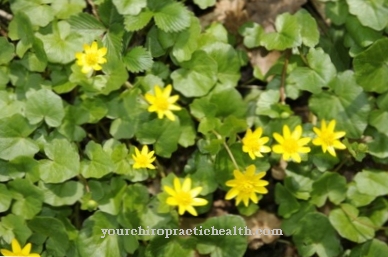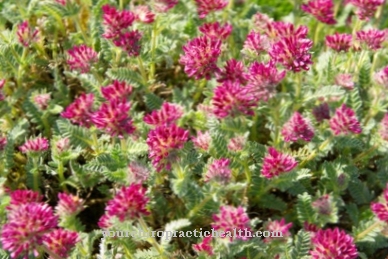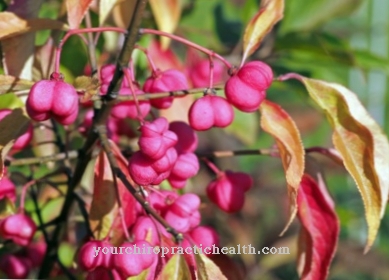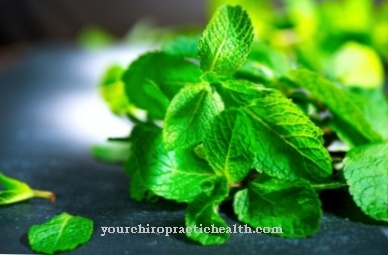The one originally from China Tea plant As an evergreen shrub or tree, it belongs to the genus of camellias from the tea shrub family. Numerous types of tea are made from the leaves of Camellia Sinensis and Camellia Assamica for the global market. The tea plant is mainly grown in the subtropical monsoon climate.
Occurrence & cultivation of the tea plant
.jpg)
The two subspecies of Tea plant, Camellia Sinensis and Camellia Assamica form the basis for by far the largest amount of tea production worldwide. The Camellia Sinensis has been grown and used as a tea drink for thousands of years. Sinensis is the Latin translation for "from China". The shrub-like plant reaches a height of three to four meters. It must therefore be trimmed during cultivation to reach a practical height for harvesting.
It should also prevent blooming and fruiting. The dark green leaves are shiny and smooth. They reach a length of about twelve centimeters and a width of about three centimeters. In addition to sub-tropical and tropical areas, the Camellia Sinensis can also be grown in harsher conditions in the highlands. Due to the slower growth, high quality is achieved there.
The main growing areas of Camellia Sinensis are China, India and Japan as well as Sri Lanka, in East Asia and in Turkey. The Camellia Assamica was discovered 150 years ago in the Indian province of Assam. The tea tree can grow up to 20 meters high and has large leaves. It needs a lot of moisture and does not tolerate frost. It thrives particularly well in flat, swampy areas. The tea made from the leaves is particularly spicy and rich.
Effect & application
The small leaves of Camellia Sinensis contain only a small amount of tannin and have a fine floral aroma. This plant is particularly suitable for the production of green tea and light light teas. Of the tea plant species Camellia Sinensis, the so-called varieties Camellia Sinensis Dehungensis and Camellia Sinensis Pubilimba are also grown in south-west and south-east China.
In addition to the properties of the tea plant, the character of the tea is determined by the nature of the soil, climatic conditions and the processing of the tea leaves. In addition to machine harvesting, many of the high-quality teas are still hand-picked. The Camellia Assamica has a higher tannin content than the Camellia Sinensis and is particularly suitable for spicy, rich teas.
Today teas are mainly grown that were bred from crosses of these two subspecies of the tea plant. These are considered to be particularly resilient and productive. Only young leaves are picked during harvest. In the further process, the leaves are prepared for final production by wilting, rolling, fermenting and drying.
An important processing step is fermentation, which influences the taste, aroma and appearance of black tea in particular. The bitter taste is reduced by combining the plant substances with oxygen. Different types of tea can be obtained from the tea plant thanks to the various production methods:
- White tea: With this type of tea, the leaves are processed in a particularly gentle process, which means that the tea largely retains its original taste and ingredients. White tea was first grown in the Chinese province of Fujian. Nowadays, high quality white teas are also made in India, Sri Lanka and Africa. White tea has a fresh and pleasantly sweet taste.
- Green tea: The many varieties of green tea are mainly produced in China and Japan. In China, the manufacturing process produces a flowery and slightly bitter taste through light roasting. In contrast, in Japan a fresh, grassy flavor is preferred. To do this, the green tea is treated with steam.
- Yellow tea: In contrast to green tea, the yellow tea obtained from the tea plant is left to rest first and only then processed. The heated tea leaves are temporarily stored in paper or fabric and then dried in different ways depending on the variety.
- Oolong: The production of this attractive and versatile type of tea is complex and requires experience. The different taste variations are created by the respective degree of fermentation.
- Black tea: To make it, the fresh leaves are spread out on grids for a day. The supple leaves are then fermented after rolling and wilting. The leaf changes color and valuable aromas are formed. Quality and taste are decisively influenced by the fermentation technology.
- Pu Erh: The traditional Chinese tea is made from the large leaves of old, wild tea trees in southwest China as well as in Burma, Vietnam and Laos. The chemical composition differs significantly from other tea plant leaves. In contrast to the usual manufacturing process, the leaves are pressed and stored in molds after withering and roasting without fermentation. It is later used to make green and dark pu erh tea.
- Matcha tea: This Japanese specialty is not a common tea infusion, but an extract from fresh, ground green tea leaves.
Importance for health, treatment & prevention
Tea not only offers a pleasant taste, but also has different effects. Black tea contains caffeine, which increases the ability to concentrate. It also contains other nutrients such as vitamin B, potassium, fluoride and manganese. These active ingredients are said to be beneficial for nerves and blood pressure, among other things.
Black tea also contains polyphenols and tannins with supposed anti-inflammatory and cancer-preventing properties. The components theobromine and theophylline are good for the bronchi. Green tea is not only popular in Asia, as it is said to have a variety of healthy effects. The ingredients include caffeine, amino acids and flavonoids (secondary plant substances) as well as polysaccharides (multiple sugars) and fatty acids.
Numerous vitamins, minerals and trace elements are also contained in green tea. This combination of valuable ingredients is said to have detoxifying, anti-inflammatory and digestive effects.It is also intended to strengthen the immune system and lower the cholesterol level. The properties of green tea also supposedly include the anti-cancer neutralization of free radicals and the strengthening of concentration and performance.
Since it improves fat metabolism and is said to accelerate fat burning, the tea is also often used in diets. In addition to caffeine, white tea contains polyphenols and secondary plant substances, which are supposed to help strengthen the immune system and the connective tissue of the skin. As with green tea, it should also stimulate the fat metabolism.
The Pu Erh tea is said to have a health-promoting effect on the immune system, the digestive tract and the metabolism and to have an anti-inflammatory and cholesterol-lowering effect. Oolong tea is said to contain valuable antioxidants and therefore have a cancer preventive effect.
In addition to caffeine, it should also contain the minerals selenium, potassium and carotene as well as vitamins A, B, C, E and K. Therefore, the oolong tea should also increase the metabolism and concentration, strengthen the immune system and be helpful in losing weight.
About 3000 different types of tea are obtained from the tea plant in different cultivation variants and manufacturing processes. In addition to many references to a health-promoting effect, the residues from pesticides are sometimes also critically discussed.

























.jpg)


